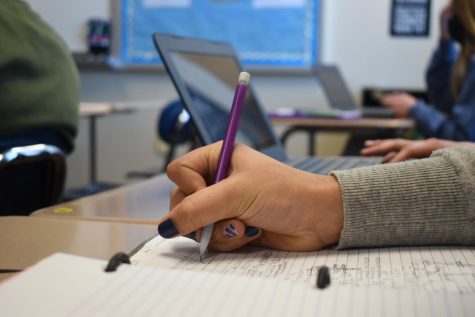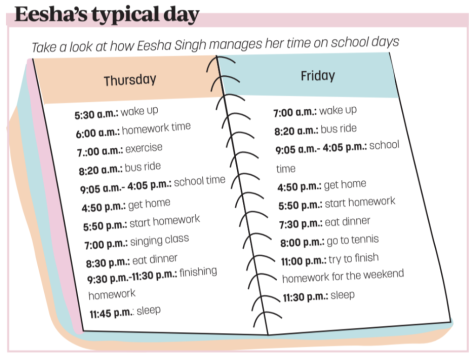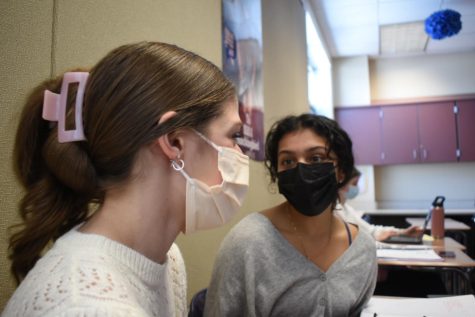Last year, millions of students transitioned into virtual and hybrid classroom settings because of the COVID-19 pandemic. Now, as students transition back into full-time in-person learning, many students’ perspectives on time management and unstructured time have changed.

in their day-to-day schoolwork and activities. (Marissa Finney)
Freshman Eesha Singh, who experienced both virtual and hybrid schooling, was one of those students.
“I never experienced what it was like to have unstructured and independent learning time before remote and hybrid schools,” Singh said. “During hybrid (school), I had more time for other activities, and I feel like it helped me academically and also created a school- and personal-life balance.”
Singh is not alone. According to a survey conducted by Education Week, 9 million teenagers in the United States experienced some form of remote learning during the 2020–2021 school year, much which was asynchronous. For her part, Singh said she and other students appreciated the independence of remote learning.

At this school, students still have unstructured time through Student Sustained Resource Time (SSRT). However, Singh said she believes SSRT is still too structured and has too many restrictions on students.
“SSRT has a lot of restrictions, as the first couple to 20 minutes are utilized by a lesson, which wouldn’t be utilized during flex time. Unstructured time can also make it so that passes aren’t really required and you can do a lot more things, like practice an instrument, study in the library or hang out in the Carmel Café,” Singh said.
Singh said she believes unstructured time should give students the ability to do almost anything, with complete independence. She said SSRT is a time usually used for homework and teacher resource time, while looser unstructured time could allow for more socialization.
Singh isn’t the only student seeing the benefits that unstructured time has for students. Katerina Folkin, TCP student and senior, said she agreed that unstructured time had its merits.
“I believe that it is important for each student to have time on their own where they can be productive in their own ways,” she said. “For example, being outside of school or even working in the library on my own is sometimes a lot more productive sometimes than sitting in class and not being productive or not being able to utilize all the time that I’d like.”

A study conducted by researchers at the University of Maryland, the University of Alabama and Concordia University Montreal found teenagers use their background and interests to define their social identity. Folkin said she believed implementing more unstructured time would allow students to pursue more extracurriculars and would not interfere with other activities outside of school.
“I think that having a (release period or unstructured time) could help students have extra time to do homework, study for their tests or work on outside things like internships, jobs or studying, especially if they have a lot of extracurriculars,” Folkin said.
CCS psychologist Kymberle Roberts said she agreed. She said extracurricular activities were beneficial to a student’s independence.
“Youth groups, sports teams, clubs, musical casts, volunteer activities, etc. do more than fill a teen’s calendar,” she said via email. “These activities give students freedom and the chance to practice being independent.”
Folkin said these activities can be implemented into unstructured time, allowing students to pursue their passions while building skills that can be beneficial for future careers. Folkin said she believes it would be beneficial for underclassmen to have the option of a release period.
“Underclassmen could have a max of one or two release periods. For example, if they are taking a lot of honors classes and harder classes, and they need that extra hour and a half to catch up on homework or even sleep, I think that would be beneficial for underclassmen,” Folkin said.

While Singh said she agreed less-restricted unstructured time was beneficial, she also said it required maturity.
“Unstructured time requires a lot of maturity because it is independent time,” Singh said. “When the school offers flex time, (students) are automatically enabled to finish homework and do other things, like practice their instrument and do social activities, which both benefit the school, their grades and their overall well-being.”
Junior Nico Jagelka said he saw the benefits of SSRT but disagreed with the idea that more unstructured time was beneficial.
“I think we do need some amount of flex time, but I think adding more wouldn’t be beneficial for all students,” Jagelka said. “I know that some students use SSRT to contact teachers, but a lot of students don’t. They use it more to mess around and some people don’t get a lot of work done during that time.”
For her part, Folkin said her release period gives her flexibility.
“Being a TCP student allows me to structure the time how I like it,” Folkin said. “So if I would like to work on something specific rather than spend time on class, it gives me the time to kind focus my energy on what’s important for the day because every single day is different for a student, so some days I want to work on homework, other days I need to study for something, and I think TCP allows and gives me the flexibility to do that.”
Singh said more unstructured time would be beneficial, allowing for a greater use of time and meaning for school.
“I think unstructured time could really benefit students in ways people don’t really think about,” she said. “(It) can create a more meaningful school experience, and I really hope it will be considered in the future.”



















![Joseph Broman, Mu Alpha Theta sponsor, grades tests for his honors precalculus/trigonometry class. Broman said, “I’m retiring from the Math Club next year and I’m just going to do Mu Alpha Theta so I can focus on that one and we can do more [speaker series] first semester.”](https://hilite.org/wp-content/uploads/2024/03/IMG_9502-1200x900.jpg)











![British royalty are American celebrities [opinion]](https://hilite.org/wp-content/uploads/2024/03/Screenshot-2024-03-24-1.44.57-PM.png)




















![Review: “The Iron Claw” cannot get enough praise [MUSE]](https://hilite.org/wp-content/uploads/2024/04/unnamed.png)
![Review: “The Bear” sets an unbelievably high bar for future comedy shows [MUSE]](https://hilite.org/wp-content/uploads/2024/03/unnamed.png)
![Review: “Mysterious Lotus Casebook” is an amazing historical Chinese drama [MUSE]](https://hilite.org/wp-content/uploads/2024/03/0.webp)
![Thea Bendaly on her Instagram-run crochet shop [Biz Buzz]](https://hilite.org/wp-content/uploads/2024/03/IMG_0165-1200x838.jpg)
![Review: Sally Rooney’s “Normal People,” is the best book to read when you are in a time of change [MUSE]](https://hilite.org/wp-content/uploads/2024/03/20047217-low_res-normal-people.webp)
![Review in Print: Maripaz Villar brings a delightfully unique style to the world of WEBTOON [MUSE]](https://hilite.org/wp-content/uploads/2023/12/maripazcover-1200x960.jpg)
![Review: “The Sword of Kaigen” is a masterpiece [MUSE]](https://hilite.org/wp-content/uploads/2023/11/Screenshot-2023-11-26-201051.png)
![Review: Gateron Oil Kings, great linear switches, okay price [MUSE]](https://hilite.org/wp-content/uploads/2023/11/Screenshot-2023-11-26-200553.png)
![Review: “A Haunting in Venice” is a significant improvement from other Agatha Christie adaptations [MUSE]](https://hilite.org/wp-content/uploads/2023/11/e7ee2938a6d422669771bce6d8088521.jpg)
![Review: A Thanksgiving story from elementary school, still just as interesting [MUSE]](https://hilite.org/wp-content/uploads/2023/11/Screenshot-2023-11-26-195514-987x1200.png)
![Review: When I Fly Towards You, cute, uplifting youth drama [MUSE]](https://hilite.org/wp-content/uploads/2023/09/When-I-Fly-Towards-You-Chinese-drama.png)
![Postcards from Muse: Hawaii Travel Diary [MUSE]](https://hilite.org/wp-content/uploads/2023/09/My-project-1-1200x1200.jpg)
![Review: Ladybug & Cat Noir: The Movie, departure from original show [MUSE]](https://hilite.org/wp-content/uploads/2023/09/Ladybug__Cat_Noir_-_The_Movie_poster.jpg)
![Review in Print: Hidden Love is the cute, uplifting drama everyone needs [MUSE]](https://hilite.org/wp-content/uploads/2023/09/hiddenlovecover-e1693597208225-1030x1200.png)
![Review in Print: Heartstopper is the heartwarming queer romance we all need [MUSE]](https://hilite.org/wp-content/uploads/2023/08/museheartstoppercover-1200x654.png)























![Review: Ladybug & Cat Noir: The Movie, departure from original show [MUSE]](https://hilite.org/wp-content/uploads/2023/09/Ladybug__Cat_Noir_-_The_Movie_poster-221x300.jpg)

![Review: Next in Fashion season two survives changes, becomes a valuable pop culture artifact [MUSE]](https://hilite.org/wp-content/uploads/2023/03/Screen-Shot-2023-03-09-at-11.05.05-AM-300x214.png)
![Review: Is The Stormlight Archive worth it? [MUSE]](https://hilite.org/wp-content/uploads/2023/10/unnamed-1-184x300.png)



